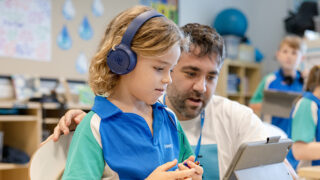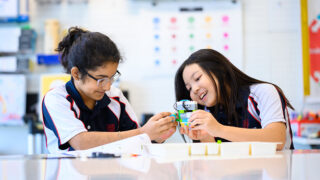In the fifth instalment of a regular series by Singapore American School (SAS) on how to design a school, Superintendent TOM BOASBERG shares how the redesigned student learning spaces on campus will support educators and learning.
The SAS school campus is currently undergoing a complete redesign and major upgrade. It already has new dining facilities and new athletic and swim facilities, while the brand new elementary school building is scheduled to open in 2024.

What new facilities can students look forward to over the next few years?
Here are just a few things that our community will benefit from:
- A significant increase in total learning, play, dining and community spaces.
- Innovative, state-of-the-art classrooms that adapt to individual student needs.
- Best-in-class sustainability features to save energy and help the school connect to nature.
- Spaces designed to enhance the wellness of community members (WELL Standard).
- New art, robotics, technical, maker and library spaces.
- Aquatics centre with 50-metre pool, APEX wellness centre and new playing fields to enhance student wellness and activity.
What’s the main factor in designing flexible student learning spaces?
All of our design discussions centred around the idea that learning should drive the design process.
This framework helps us ensure that when the inevitable trade-offs and decisions need to be made along the way, we prioritise what is most important: learning.
We recognise that learning is a complex and evolving craft, and our goal is to create student learning spaces that do not lock us into or out of any specific learning style. These spaces should be able to flex to the needs of our students and our learning aspirations.
Hear from a teacher
Middle School English Language Arts teacher James Toney was involved in the original design of the new school building. He talks about how student learning spaces that facilitate collaboration enhance the teaching and learning experience at SAS.
“When there’s flexibility of space, like in our Learning Community environment, it becomes really convenient for small group work. Be it book clubs, students who need to break out and work with support while other students continue in the bigger group, students who need to record audio or visual or students who just need to work alone for a while, all of these are easier.
As colleagues share a space, there’s constant collaboration, which also helps foster connections between our subject areas to benefit students. Conversations about what’s going on across classes are organic and teaching together becomes more a part of our DNA. All the adults in the place can become go-to resources for all learning and students could potentially see their core teachers as more than just experts in one subject.
I was involved in the original design. There’s been a lot of growth in later designs of the new building, which is an evolution of constructive feedback from students, parents and teachers, and people listening to said feedback. I can’t wait to teach in the new school building, it’s going to be amazing!”
Singapore American School is at 40 Woodlands Street 41.
6363 3403 | sas.edu.sg
This article first appeared in the April 2023 edition of Expat Living. You can purchase the latest issue or subscribe, so you never miss a copy!
To make the most of living in Singapore, read our latest City Guide here for free!







